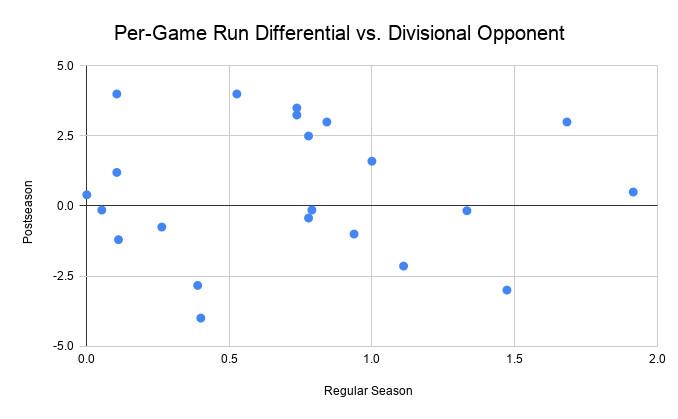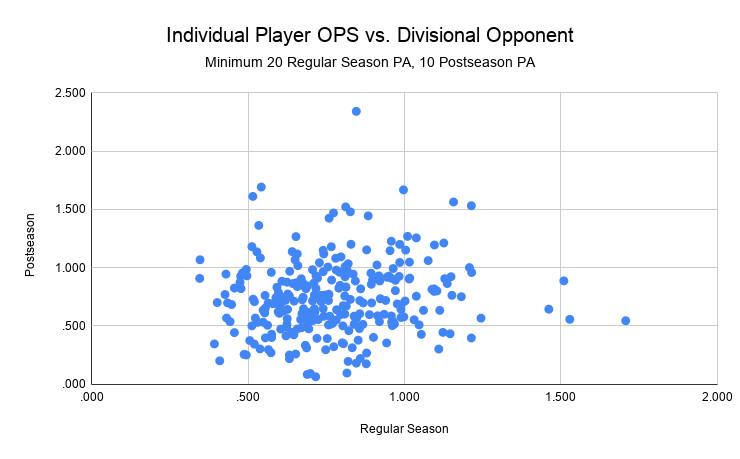The 2020 postseason sure puts the “division” in “division series.” Each of the four contests in this round, which starts Monday, matches divisional foes: Yankees and Rays, Astros and A’s, Marlins and Braves, Padres and Dodgers. (If only the word “Dodgers” rhymed with the other higher-seeded team names here, too.)
Sparks could fly, with no off days to calm any tensions or let story lines simmer: Some of these teams very much don’t like each other, and as in the case of most intradivisional playoff clashes, each series contains an element of the little brother trying to take out his older, more successful sibling. Sometimes that effort succeeds (see: Marlins over Braves in 1997, Red Sox over Yankees in 2004, Cubs over Cardinals in 2015) and sometimes it fails (see: Yankees over Red Sox in 2003, Yankees over Orioles in 2012, Cardinals over Pirates in 2013), but it’s always compelling, no matter the result.
Before the wild-card era (which started in 1995), it was impossible for teams from the same division to play each other in the playoffs, as only one team per division qualified. Since then, 22 playoff matchups have paired intradivisional opponents.
Intradivisional Playoff History
Another commonality in this set of division series is that the higher-seeded team won the regular-season series in each, as well as posted a run differential of at least plus-1 per game. (Atlanta’s robust run differential is aided by a 29-9 shellacking in one game.) So it follows that they’d also all have an advantage in the upcoming playoff series, having proved they can already beat the second-place clubs below them.
2020 Division Series Matchups
There’s only one problem with this conclusion: Regular-season meetings between two teams are not predictive at all for what happens when those teams face off in the playoffs.
This graph shows the 22 previous intradivisional playoff matchups plotted by run differential per game. If there were a meaningful relationship between regular-season and postseason performance against the same team, we’d see it on this graph. But the dots are scattered randomly; there’s no pattern whatsoever.

The correlation between regular-season and postseason run differential for these 22 series is a whopping 0.004, on a scale in which 0 represents no relationship and 1 a perfect link. Take out the five wild-card matchups in the data set so only longer series are included, and the correlation drops to a slight negative figure.
In other words, Yankees fans shouldn’t worry about an inability to beat the Rays, despite a 2-8 showing in the regular season. After all, a Yankees team with most of the same players beat a Rays team with most of the same players in 12 of 19 meetings a year ago, with a plus-40 run differential. Nor should Marlins partisans fear a 20-run loss at any point in the NLDS, just because one struck them against Atlanta in the regular season. The relatively small sample of games—an even greater concern this season, when division rivals played 10 times instead of the usual 19—explains part of the discrepancy; so do changing rosters, because the teams that play in the regular season aren’t quite the same as those who will match in the playoffs. For instance, Jordan Yamamoto allowed 13 runs (12 earned) in 2 2/3 innings against Atlanta this season; he will not pitch in the NLDS.
Moreover, a number of prominent position players missed at least half of their meetings against the division series opponent, which limits the predictability of those results:
- Aaron Judge missed six games against the Rays
- Giancarlo Stanton missed seven games against the Rays
- Randy Arozarena missed seven games against the Yankees
- José Altuve missed five games against the Athletics
- Eric Hosmer missed six games against the Dodgers
- Austin Nola (traded to San Diego midseason) missed eight games against the Dodgers
- Ozzie Albies missed five games against the Marlins
The same is true of pitchers who are expected to either make a start in the division series or serve as closers:
- J.A. Happ pitched zero innings against the Rays
- Aroldis Chapman pitched one inning against the Rays
- Mike Clevinger and Trevor Rosenthal (both traded to San Diego midseason) both pitched zero innings against the Dodgers
- Sandy Alcantara pitched zero innings against the Braves
If not on a team level, then do individual results in the regular season matter against the same opponents in the playoffs? Mookie Betts hit .429/.467/.786 against San Diego this year, while his Padres counterpart, Fernando Tatis Jr., managed a mere .205/.244/.385 line against Dodger pitchers—does that mean Betts is better positioned to star in the battle between the two best teams in the National League?
Aside from Matt Chapman, who hit .450/.450/1.000 against Houston this year but is out for the season with a hip injury, Betts actually had the best regular-season performance for any player against his division-series opponent (minimum 20 plate appearances). This list shows the top 10, ordered by OPS.
Top 10 Performers Against Division Series Opponent in 2020
And here are the 10 worst such performances; note the prominent presence of four Astros, including three stars.
Bottom 10 Performers Against Division Series Opponent in 2020
Yet the same caveats for team performance apply to individuals as well. The correlation between regular and postseason OPS for individual players in these intradivisional series is just 0.12, signifying a very weak relationship. Adjust for the overall quality of the batter—because someone like Betts would expect to perform well against any opponent—and the correlation drops to 0.02.
Like in the team graph above, there’s not much of a pattern on this graph, either. (For curious readers, the dot all the way at the top belongs to Jorge Soler, who hit .571/.769/1.571 against the Cardinals in the 2015 NLDS.)

So although Betts pounded Padres pitching in the regular season and Tatís struggled against the Dodgers, that disparity might not hold in the next series. The A’s staff probably won’t continue to hold the Astros’ brightest stars to pitcher-esque batting lines. The samples are simply too small to mean much.
Although that analysis examines only position players, it stands to reason that pitcher performance against a team in the regular season wouldn’t be any more predictive of their postseason chances. Batters tend to improve slightly the more times they face particular pitchers in their careers—the so-called familiarity effect—but that effect should apply evenly across pitchers, not hinging on how well they did in the regular season. For instance, in three starts against Tampa Bay this season, Yankees ace Gerrit Cole, who will start against Blake Snell in Game 1, tallied a 4.96 ERA and 1.59 WHIP while lasting just 5.4 innings per start. Is that the “real” Cole against Tampa? Maybe—but this is also the same pitcher who, as a member of the Astros, completely dominated a similar Rays lineup in two starts in last year’s ALDS: a 2-0 record, 0.57 ERA, and 0.57 WHIP, along with 25 strikeouts in 15 2/3 innings.
The Rays might win the series anyway. Ditto the Dodgers, A’s, and Braves. They’re the higher seeds, after all. But if they advance over their respective division runner-ups, they’ll do so because they’re the better teams overall—not because they happen to have their opponents’ number. The history of these intradivisional playoff matchups shows that such regular-season possibilities don’t carry over to the playoffs.
